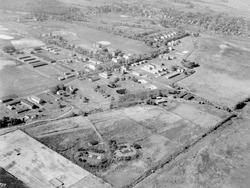39°34′17″N 75°35′01″W / 39.57139°N 75.58361°W
| Fort DuPont | |
|---|---|
| Part of Harbor Defenses of the Delaware | |
 Parade grounds at Fort DuPont | |
| Type | Fortification |
| Site information | |
| Owner | Public - State of Delaware |
| Open to the public | Yes |
Fort DuPont Historic District | |
 Fort DuPont aerial view 1927, Abbot Quad mortar battery in center | |
| Location | Delaware City, Delaware |
| Area | 350 acres (140 ha) |
| Built | 1863–1945 |
| Architect | Army Corps of Engineers Army Quartermaster Department |
| Architectural style | Colonial Revival |
| NRHP reference No. | 99001275[1] |
| Added to NRHP | 1999 |
| Site history | |
| Built | 1863–1864, 1870–1875, 1897–1904, 1941–1942 |
| Built by | U.S. Army Corps of Engineers |
| In use | 1863–1875, 1899–1924, 1941–1945 |
| Materials | Reinforced concrete, earth |
Fort DuPont, named in honor of Rear Admiral Samuel Francis Du Pont, is located between the original Delaware City and the modern Chesapeake and Delaware Canal on the original Reeden Point tract, which was granted to Henry Ward in 1675. Along with two other forts of the Harbor Defenses of the Delaware, it defended the Delaware River and the water approach to Philadelphia from 1900 through 1942. In 1992 a portion was redesignated as Fort DuPont State Park, which became Delaware's 13th state park. In 2016, the acreage which is not in the state park system was annexed into Delaware City.
The first fortification built was the Ten Gun Battery, an auxiliary to nearby Fort Delaware during the American Civil War.[2] The Twenty Gun Battery was constructed on the reservation during the 1870s, later followed by a mine control casemate for an underwater minefield in 1876.[3] In 1897-1904, Endicott-era emplacements were constructed for long-range rifles, mortars, and rapid-fire guns.[4] In 1922 the post became headquarters for the 1st Engineer Regiment, which remained at the post until 1941. During World War II, Fort DuPont served as a mobilization station for deploying units, and contained a prisoner-of-war camp for captured German soldiers and sailors. After the war, Fort DuPont was declared surplus and offered to the Veterans Administration for use as a veterans hospital. After they declined, the state bought the site at a 100 percent discount and adapted existing structures for reuse. In 1948, it officially opened as the Governor Walter W. Bacon Health Center.
In 1999 the site was officially designated the Fort DuPont Historic District after it was listed in the National Register of Historic Places.[5] The historic district comprises Fort DuPont State Park and the Governor Bacon Health Center.[6][7] The site is currently being redeveloped by the Fort DuPont Redevelopment and Preservation Corporation.
- ^ "National Register Information System". National Register of Historic Places. National Park Service. January 23, 2007.
- ^ "Fort Delaware Society". Fortdelaware.org. 2012-04-25. Retrieved 2012-08-15.
- ^ Harbor Defenses of the Delaware at American Forts Network
- ^ Ames, David L., Dean A. Doerrfield, Allison W. Elterich, Caroline C. Fisher, and Rebecca J. Siders. Fort DuPont, Delaware: An Architectural Survey and Evaluation. Newark, DE: University of Delaware, Center of Historic Architecture and Engineering, 1994.
- ^ J., Siders (Sheppard), Rebecca; Anna, Andrzejewski (8 March 1999). "Fort Dupont Historic District". Retrieved 9 June 2016.
{{cite journal}}: Cite journal requires|journal=(help)CS1 maint: multiple names: authors list (link) - ^ "Historic Fort Dupont Complex Redevelopment - Background" (PDF). Retrieved 9 June 2016.
- ^ "Fort Dupont Historic District: Delaware City, Delaware Historical Places". Archived from the original on 30 September 2013. Retrieved 9 June 2016.


